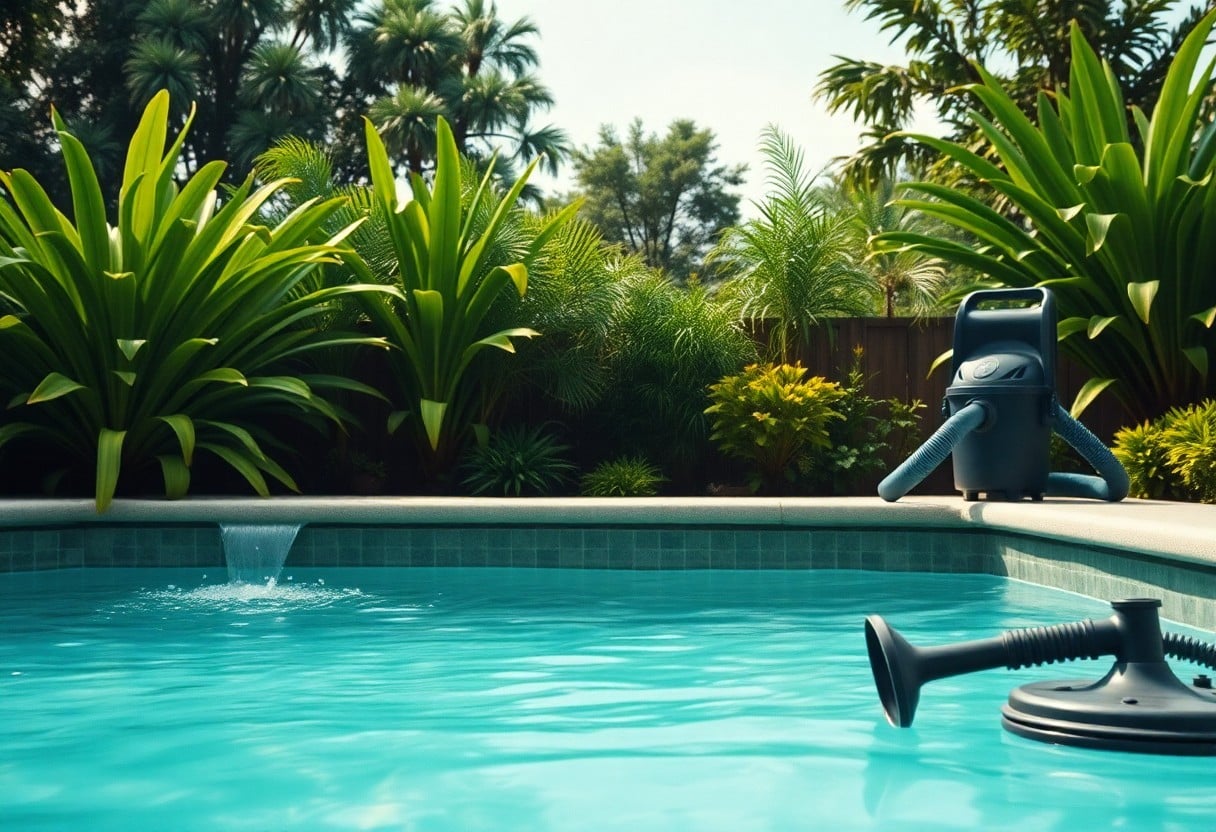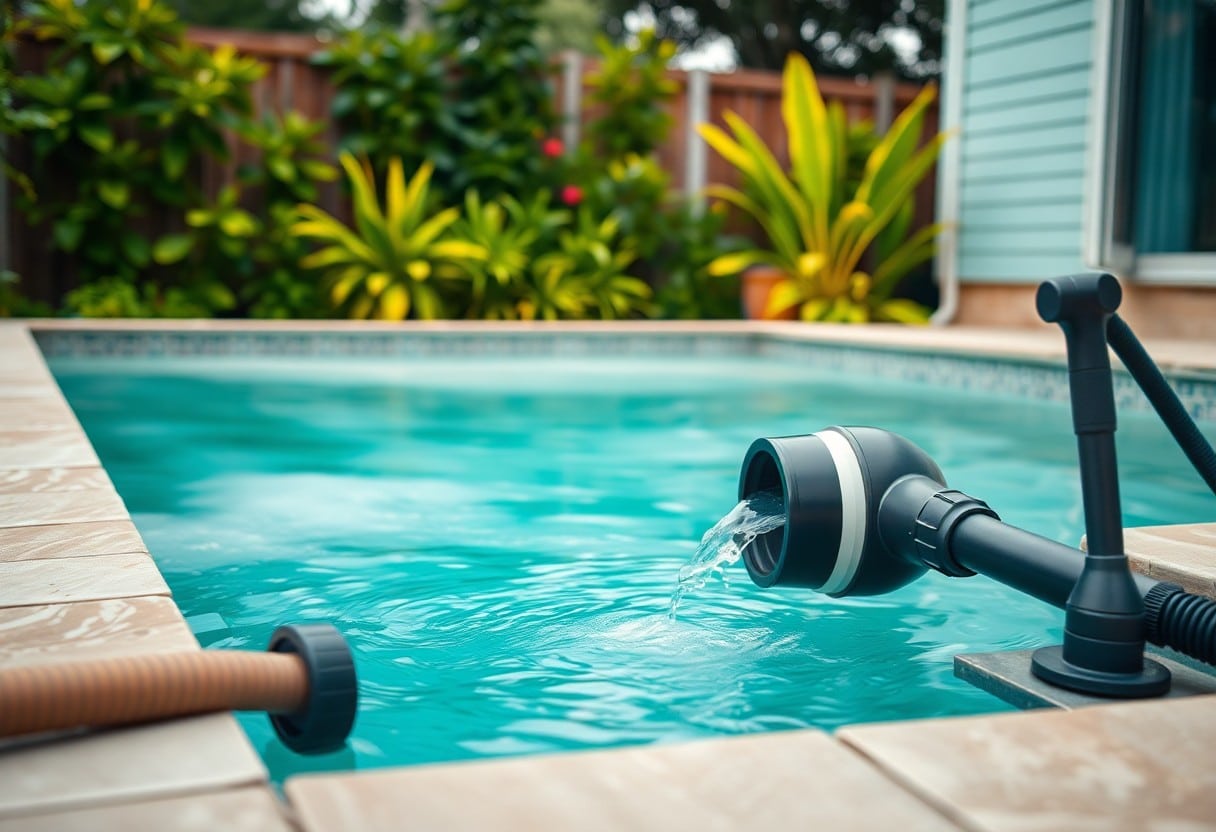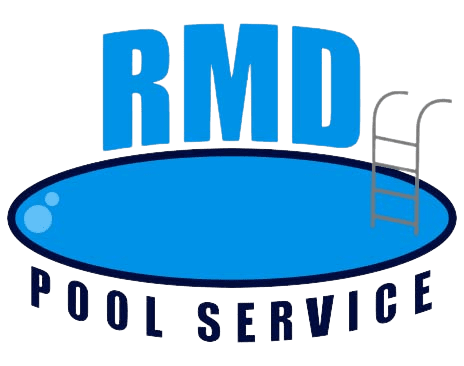Water clarity is key to enjoying your pool, and cloudy green water can turn a refreshing oasis into an unsightly mess. If you find yourself staring at murky water instead of a crystal-clear pool, you can take actionable steps to restore its beauty. In this guide, you’ll learn how to identify the causes of cloudy green water and implement effective solutions to bring your pool back to life, ensuring it’s safe, clean, and ready for splashing fun.
Diagnosing the Problem: Identifying Causes of Cloudiness
Identifying the root cause of cloudy green pool water is the first step toward restoring its clarity. You need to consider various factors that contribute to water quality, such as biological growth, chemical imbalance, and equipment malfunctions. Taking a systematic approach to diagnosing these issues can help you efficiently target the appropriate solutions and restore your pool to its sparkling state.
Algae Blooms: The Green Menace
Algae blooms are often the primary culprits behind cloudy green water. Warm temperatures and excess nutrients foster the growth of these pesky organisms, leading to unsightly green pools. Once algae take hold, they can quickly multiply, further complicating your pool maintenance efforts, so addressing their presence is necessary for restoring your pool’s clarity.
Water Chemistry: pH, Chlorine Levels, and More
The balance of your pool’s water chemistry plays a significant role in its overall clarity. Imbalanced pH levels, inadequate chlorine, and high levels of combined chlorine can create an environment that promotes cloudiness. Regular testing of these factors is necessary to ensure your pool remains inviting and safe for swimming.
In particular, pH levels should ideally be between 7.4 and 7.6 for optimal chlorine effectiveness. If the pH is too high, chlorine becomes less effective at killing contaminants, which can worsen cloudy water conditions. Similarly, maintaining a free chlorine level of between 1 to 3 parts per million (ppm) is necessary. If your tests show combined chlorine levels above 0.2 ppm, it may be time for a shock treatment to help clear your pool efficiently.
Filtration Failures: Understanding Your System
A properly functioning filtration system is vital for maintaining clear pool water. Any dysfunction in your filtration, such as a dirty filter or insufficient pump running time, can lead to the accumulation of debris and contaminants, which contribute to cloudiness. Regular maintenance checks on these components will help ensure optimal performance.
Your pool’s filtration system, whether it’s a sand, cartridge, or diatomaceous earth (DE) filter, requires routine maintenance to function effectively. Clogged filters can’t remove debris efficiently, leading to murky water. Ensure you clean or replace your filter cartridges according to manufacturer guidelines, backwash sand filters as needed, and confirm your pump is operating at the correct flow rate. Monitoring these elements will enhance the clarity of your pool and extend the life of your filtration system.

First Steps to Recovery: Immediate Actions to Take
To tackle cloudy green pool water, prompt actions are necessary. Start by assessing the situation: inspect for visible debris, test your water, and determine if any immediate cleaning is required. Addressing these immediate concerns will set the stage for a more thorough treatment plan and ensure that you aren’t just delaying the problem further.
Testing Water Parameters: Tools and Techniques
Using a reliable test kit is the first step to understanding your pool’s chemistry. Test for pH, alkalinity, chlorine levels, and stabilizer concentration. Dipping test strips can give quick insights, but a liquid test kit often provides more accurate results. By knowing these levels, you can make informed decisions about the necessary adjustments needed for your pool’s recovery.
Shock Treatment: The Power of Chlorine
Shock treatment is a pivotal step in eliminating algae and contaminants from your pool. Applying a strong dose of chlorine helps to quickly raise the free chlorine levels, which can destroy harmful bacteria and algae, restoring your pool’s clarity.
For effective shock treatment, calculate the size of your pool and use approximately 1 pound of shock for every 10,000 gallons of water. You can choose from different types of shock, such as calcium hypochlorite or sodium dichlor, depending on your pool type. Remember to run your filter continuously for 24 hours post-shock application to help clear up the water more efficiently.
Manual Removal: Cleaning Debris and Algae
With the initial chemical treatments in place, it’s time to manually remove any visible debris and algae buildup. Skim the surface with a net to remove leaves and floating particles, followed by vacuuming the pool floor to capture sediment. This hands-on approach complements your chemical treatments, speeding up the recovery process.
Consider using a fine-mesh net for skimming, as it captures smaller debris that larger nets may miss. For vacuuming, ensure your vacuum is set to the correct settings for your pool type. After manual removal, your pool will be one step closer to becoming crystal clear, allowing the chemicals to work more effectively without debris hindering their mission.

The Long-Term Solution: Preventing Recurrence
To ensure your pool remains inviting and crystal clear, implementing preventive measures is crucial. Regular maintenance, diligent water testing, and proper pool equipment upkeep work synergistically to create a sustainable swimming environment that minimizes the chance of cloudy water reappearing.
Regular Maintenance: Best Practices for Crystal Clear Water
Establishing a regular cleaning schedule helps keep your pool in top condition. Skim the surface, brush the walls, and vacuum the bottom at least once a week to remove debris and prevent algae buildup, ensuring the water remains pristine and inviting.
Balancing Water Chemistry: Keeping Levels Stable
Consistent monitoring and balancing of your pool’s water chemistry are vital for preventing issues like cloudiness. Aim for a pH level between 7.2 and 7.6, maintaining appropriate levels of chlorine, alkalinity, and calcium hardness to keep your water balanced and debris-free.
Testing your water chemistry at least weekly helps catch imbalances before they escalate. Use a reliable pool test kit to check for cyanuric acid and total dissolved solids, adjusting chemical levels as needed. Keeping your chlorine level between 1-3 ppm and alkalinity in the range of 80-120 ppm will ensure effective sanitation and clarity of water, making it difficult for algae and bacteria to thrive.
Pool Equipment Upkeep: Filters, Pumps, and More
Your pool equipment plays a key role in maintaining water quality. Regularly clean or replace filter cartridges, inspect and test pumps, and ensure skimmers and drains are free of debris to maximize water circulation and filtration.
Paying attention to your pool’s hardware is equally important. A dirty or clogged filter can hinder circulation and lead to cloudiness. Clean your filter according to the manufacturer’s recommendations, typically every 4-6 weeks. Also, check pump operation frequently; an underperforming pump may not effectively distribute chemicals or manage debris, leading to poor water clarity.
When to Call in the Experts: Recognizing Professional Help
Identifying when to bring in a professional can save you both time and frustration. If your pool remains cloudy after performing routine maintenance, or if you notice persistent algae growth and imbalanced chemical levels, it’s wise to seek expert assistance. Complex issues such as major equipment failures, extensive leaks, or severe contamination can require specialized knowledge and equipment that goes beyond standard DIY approaches.
Signs You Need a Pool Technician
Watch for indicators that suggest it’s time to call in a pool technician. If water clarity issues persist despite proper treatment, or you notice a strong chemical odor, excessive bacteria development, or unusual stains on your pool surfaces, these are signs of underlying problems. Additionally, if your filtration system struggles to keep up or if you experience frequent equipment malfunctions, professional intervention is likely necessary.
Choosing the Right Service Provider
Selecting the appropriate pool service provider can significantly affect the outcome of your maintenance efforts. Look for a technician with relevant certifications, solid customer reviews, and a clear track record in addressing cloudy pool water issues. It’s advisable to obtain multiple quotes and inquire about their experience with specific issues you’ve encountered to ensure they’re the right fit for your needs.
When researching service providers, consider their approach and transparency regarding pricing and services offered. A reputable company should provide a detailed breakdown of what is included in their service, such as water testing, equipment maintenance, and chemical balancing. Additionally, inquire about their response times for emergency situations and whether they offer follow-up visits to ensure your pool remains in pristine condition. By asking these questions, you can build confidence in your choice and ensure your pool receives the expert care it requires.

The Benefits of a Clear Pool: Enjoyment and Health
A clear pool enhances your enjoyment and well-being, offering a refreshing retreat for leisurely swims and gatherings. With pristine water, you can relax and socialize without the worry of murky depths obstructing visibility. This not only revitalizes your outdoor space but also promotes outdoor activity, encouraging you and your family to prioritize health and fitness through regular swimming sessions.
Enhancing Aesthetics: Transforming Your Backyard Oasis
A clear pool transforms your backyard into a stunning oasis, making it an inviting focal point for outdoor gatherings. The sight of sparkling water adds a touch of luxury and tranquility, complementing your landscape design and elevating the overall atmosphere of your space. This aesthetic appeal can even increase your home’s value, creating a desirable environment for family and friends.
Health Considerations: Addressing Hygiene and Safety
Clear water is not just appealing; it directly impacts your health and safety. Swimming in clean water reduces the risk of infections and other health issues, ensuring a safe environment for you and your loved ones. Regular maintenance and appropriate chemical treatments help to eliminate harmful bacteria and algae, significantly lowering the chances of skin irritations and respiratory problems commonly linked to poorly maintained pools.
In a safe swimming environment, your risk of encountering harmful pathogens drops dramatically. For instance, the Centers for Disease Control and Prevention (CDC) recommends maintaining proper chlorine levels between 1-3 parts per million (ppm) to effectively kill pathogens. This simple act of maintaining clarity in your pool underscores its importance, as a well-kept pool fosters better hygiene and reduces the probability of ailments such as gastrointestinal infections. Routine testing of pH and alkalinity also contributes to a healthier swimming experience, allowing you to enjoy your pool without concerns about waterborne illnesses.
To wrap up
To wrap up, addressing cloudy green pool water requires a methodical approach to restore clarity and safety. Begin by testing your water to identify chlorine and pH levels, then adjust them as needed. Regularly clean your pool’s filters and brush the surfaces to eliminate debris and algae. Additionally, shock your pool with appropriate chemicals to kill off any remaining contaminants, followed by thorough vacuuming. By consistently maintaining your pool’s balance and cleanliness, you can ensure a crystal-clear swimming experience all season long.
